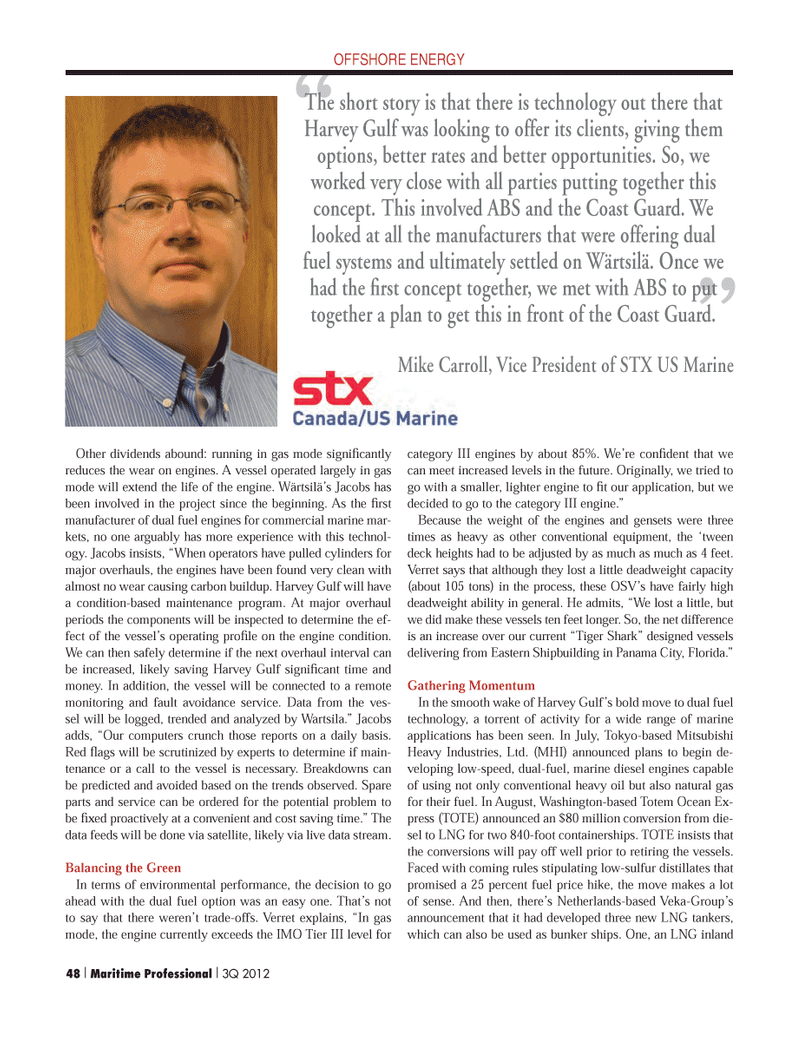
Page 48: of Maritime Logistics Professional Magazine (Q3 2012)
Classification Societies, Quality & Design
Read this page in Pdf, Flash or Html5 edition of Q3 2012 Maritime Logistics Professional Magazine
?Other dividends abound: running in gas mode signiÞ cantly reduces the wear on engines. A vessel operated largely in gas mode will extend the life of the engine. W?rtsil?Õs Jacobs has been involved in the project since the beginning. As the Þ rst manufacturer of dual fuel engines for commercial marine mar- kets, no one arguably has more experience with this technol- ogy. Jacobs insists, ÒWhen operators have pulled cylinders for major overhauls, the engines have been found very clean with almost no wear causing carbon buildup. Harvey Gulf will have a condition-based maintenance program. At major overhaul periods the components will be inspected to determine the ef-fect of the vesselÕs operating proÞ le on the engine condition. We can then safely determine if the next overhaul interval can be increased, likely saving Harvey Gulf signiÞ cant time and money. In addition, the vessel will be connected to a remote monitoring and fault avoidance service. Data from the ves- sel will be logged, trended and analyzed by Wartsila.Ó Jacobs adds, ÒOur computers crunch those reports on a daily basis. Red ß ags will be scrutinized by experts to determine if main- tenance or a call to the vessel is necessary. Breakdowns can be predicted and avoided based on the trends observed. Spare parts and service can be ordered for the potential problem to be Þ xed proactively at a convenient and cost saving time.Ó The data feeds will be done via satellite, likely via live data stream. Balancing the Green In terms of environmental performance, the decision to go ahead with the dual fuel option was an easy one. ThatÕs not to say that there werenÕt trade-offs. Verret explains, ÒIn gas mode, the engine currently exceeds the IMO Tier III level for category III engines by about 85%. WeÕre conÞ dent that we can meet increased levels in the future. Originally, we tried to go with a smaller, lighter engine to Þ t our application, but we decided to go to the category III engine.Ó Because the weight of the engines and gensets were three times as heavy as other conventional equipment, the Ôtween deck heights had to be adjusted by as much as much as 4 feet. Verret says that although they lost a little deadweight capacity (about 105 tons) in the process, these OSVÕs have fairly high deadweight ability in general. He admits, ÒWe lost a little, but we did make these vessels ten feet longer. So, the net difference is an increase over our current ÒTiger SharkÓ designed vessels delivering from Eastern Shipbuilding in Panama City, Florida.Ó Gathering MomentumIn the smooth wake of Harvey GulfÕs bold move to dual fuel technology, a torrent of activity for a wide range of marine applications has been seen. In July, Tokyo-based Mitsubishi Heavy Industries, Ltd. (MHI) announced plans to begin de- veloping low-speed, dual-fuel, marine diesel engines capable of using not only conventional heavy oil but also natural gas for their fuel. In August, Washington-based Totem Ocean Ex- press (TOTE) announced an $80 million conversion from die- sel to LNG for two 840-foot containerships. TOTE insists that the conversions will pay off well prior to retiring the vessels. Faced with coming rules stipulating low-sulfur distillates that promised a 25 percent fuel price hike, the move makes a lot of sense. And then, thereÕs Netherlands-based Veka-GroupÕs announcement that it had developed three new LNG tankers, which can also be used as bunker ships. One, an LNG inland ?The short story is that there is technology out there that Harvey Gulf was looking to offer its clients, giving them options, better rates and better opportunities. So, we worked very close with all parties putting together this concept. This involved ABS and the Coast Guard. We looked at all the manufacturers that were offering dual fuel systems and ultimately settled on Wärtsilä. Once we had the rst concept together, we met with ABS to put together a plan to get this in front of the Coast Guard. Mike Carroll, Vice President of STX US Marine OFFSHORE ENERGY48 I Maritime Professional I 3Q 2012

 47
47

 49
49
